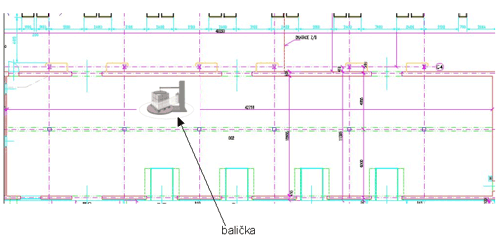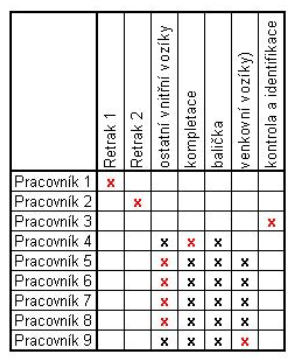The warehouse design: MEVATEC Ltd.

The case study in pdf you can download here.
APPLICATION:
The warehouse optimization
BRANCH:
The logistic centrum with the short and long turnaround
BENEFIT:
The verification of a presumed future state depending on a season and customer demand fluctuations. The handling technology optimization and a design of a packing machine.
About the company
MEVATEC is located in Roudnice nad Labem and it is the most important supplier of products of the environment area. It offers trashes cans, products for oil industry, products for storage, workshop equipment, office equipment, handling technology. The products are sold using the e-shop and catalogue sale.
Project targets
The project target was to verify storage capacity of individual types of storage products, requirements and options of handling technology and utilization of service workers. On the basis of created dynamic simulation model and the bottlenecks analysis of bottlenecks in the proces of handling and storage of the individual types of products including the verification of fluctuations on season basis and possibility of increasing customer requierements´ number and propose the changes which will lead to remove bottlenecks, ensure the throughput among all the storage places with the goal of reducing process costs and fulfill all the customers´ requirements.
The data analysis
With regard to customer products input and output development which is influenced by a season and customers´ demand we tried to verify the presumed future state at quite long simulation period. That´s why was the first analysis performed during more than one year. Next analysis were for the one month periods. We analysed the whole presumed process, the capacity of a warehouse area and racks, handling opportunities, dispatching opportunities. There were verified bottlenecks, the throughput and the proposed system in a dispatching warehouse. All alternatives of simulation experiments were tested with the target of optimization of combination of these determined parametres with ensuring the storage and dispatching requirements and the ability to handle the required volume of products.
The simulation model
The dynamic simulation model (see the picture) involved logistic processes, i.e. material income, input control, hub storage process places, material dispatching according to customers´ requirements, material handling during transport to hub places for completion, completion of dispatched supplies, mark of dispatching palletes and loading of prepared dispatching deliveries to transport vehicles, storage possibilities for individual types of goods in needed warehouse parts, capacity verification and designs of storage of particular product types according to the reality. In the model we captured work of handling technology in the incoming place, in the inside warehouse or outside areas and work of individual workers at the incoming/dispatching place, at input control, at completion and at the others activities which are related to product income and outcome according to required orders. All the handling requirements or workers´ activities came out of the real requirements from the analysis of past development at income and dispatching. Knowlegde of characteristics of particular type of products, work system proposals in the new dispatching warehouse and strict characteristics of handling technology, packing machine or a possibility to complete finished products ensured for the model needed input data for the simulation of a future state and to design alternatives of possible development of optimizing the whole handling process and storage in a new dispatching warehouse.
Picture – the dynamic simulation model of the dispatching warehouse

Outputs and recommendations
On the basis of the created model and the simulation of tested experiments of individual parametres settings in the storage process, handling, completion and goods, dispatching in the dispatching warehouse, we reached these conslusions which have been implemented to the practice for setting of the most appropriate parametre setting with the target to material flow optimization, ensuring the throughput of requirements in the whole process of storage and handling and to reach the operational costs reduction.
The bottleneck in the storage process was the insufficient capacity of a handling vehicle Retrak. This deficit is reflected mainly in some days at maximum increase of requirements to storage and dispatching from the rack positions. The other bottleneck in the process of product outcoming was the workers´ deficit at many requirements to input and output at completion places. We defined this deficit due to waiting for the completion place of a worker. These bottlenecks caused the impossibility to handle the huge requirement increase which caused the requirement shifts to the next day.
The work optimization proposals in a new dispatching warehouse come out from the identification of the work of handling technology and operation workers. The performed dynamic simulation verified the functionality of the proposed changes of work systém of individual workers. For the more appropriate handling technology work we identified these area assignment to the individual handling facilities.
Tab – the handling technology work

Due to large fluctuations of storage and dispatching requirements (and the tab shows it too) and with regard to presumed requirement increase we recommend add another vehicle Retrak to the handling technology.
Depending on the average power of these vehicles is needed to say that utilization of handling technology over 50% of possible work time puts grat demands to the handling technology and it could have a negative effect to vehicles, respectivelly to their falilure rate and cost increase to the maintenance and repairs.
The next proposed change in the dispatching warehouse is the design of the packing machine placement. With the help of the simulation experiments we reached these two conslusions of space solution. See the picture.
Picture – the most appropriate placement of the packing machine (spatial solution)

This spatial solution brings saving of traveled distance of handling technology and it ensures more appropriate placement of the possible material flow viewpoint.
Of the operational workers´ viewpoint we proposed the matrix of assignment the individual activities to the individual workers. For the fulfillment all the requirements and ensuring the decrease of waiting times to the completion or the other actitivity we propose the overall 9 workers.
Tab – the matrix of activity assignment to the individual workers

We assign priority activity to the individual workers. Then it could not exist a deficit of workers, in case of standard requirements. The worker no. 4 will be priority assign for the completion needs, the worker no. 3 will be priority assign for the incoming control and the indentification of received goods. We assigned two workers for the work with handling vehicles Retrak because there is big demand of the handling activities viewpoint.
The part of the verification of individual technologies was also the verification of utilization and number of facilities for a barcode. We verified values of terminal (scanner) using for the barcode and barcode printers. We found out that i tis not possible to reduce their number because it would be mean add a minimum one worker who would run among places where the requirement for barcode reading arised and this worker would take the scanner over.
The part of this study was also the recommendation of stock sizes of different product types at different models of stocking up. At the same time we set the size of the stocks of individual types of goods including insurance stocks identified storage of goods divided by group turns the following schemes.
Scheme – stock placement including insurance stocks in the racks (groups A+G, B)
